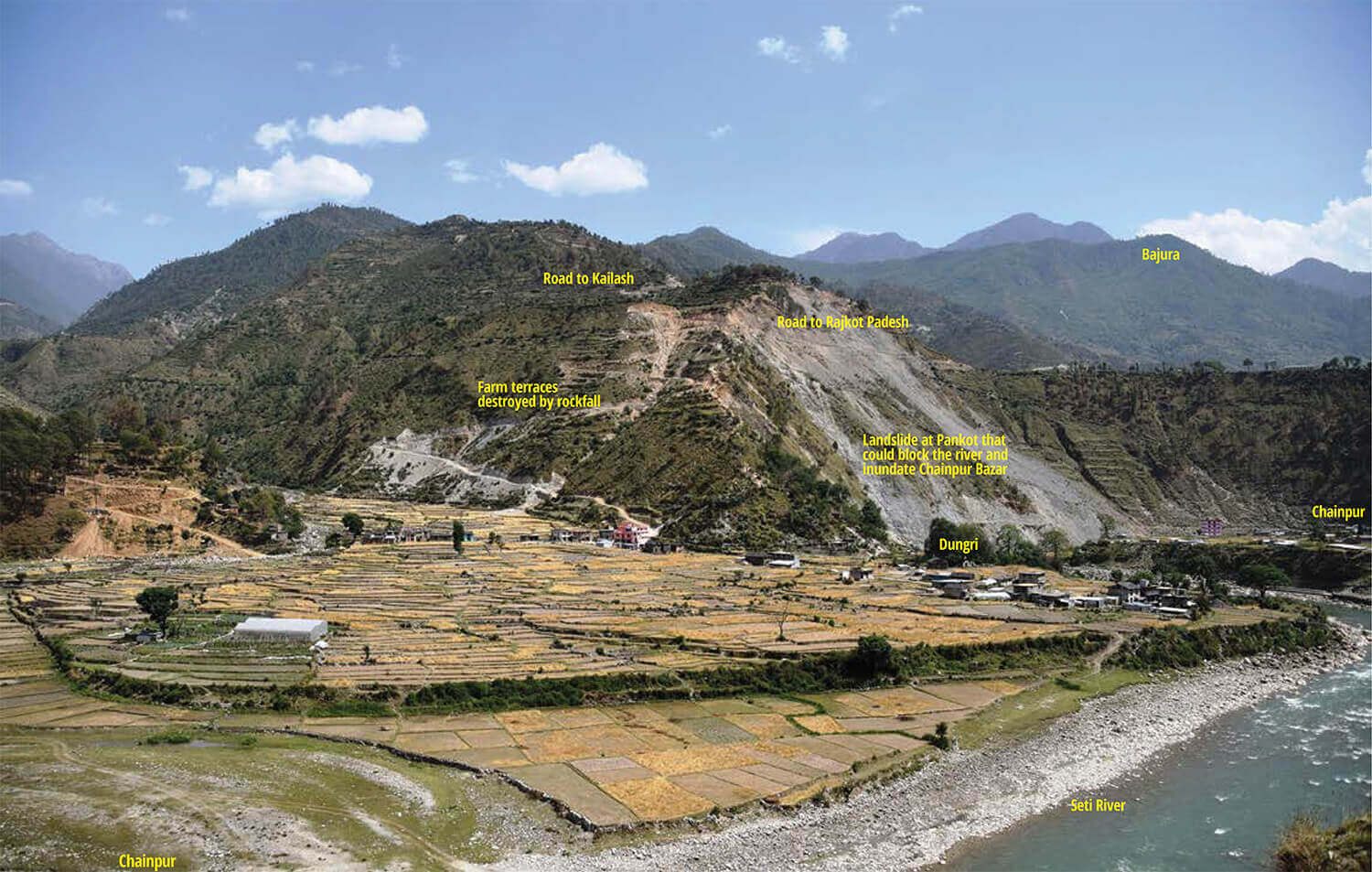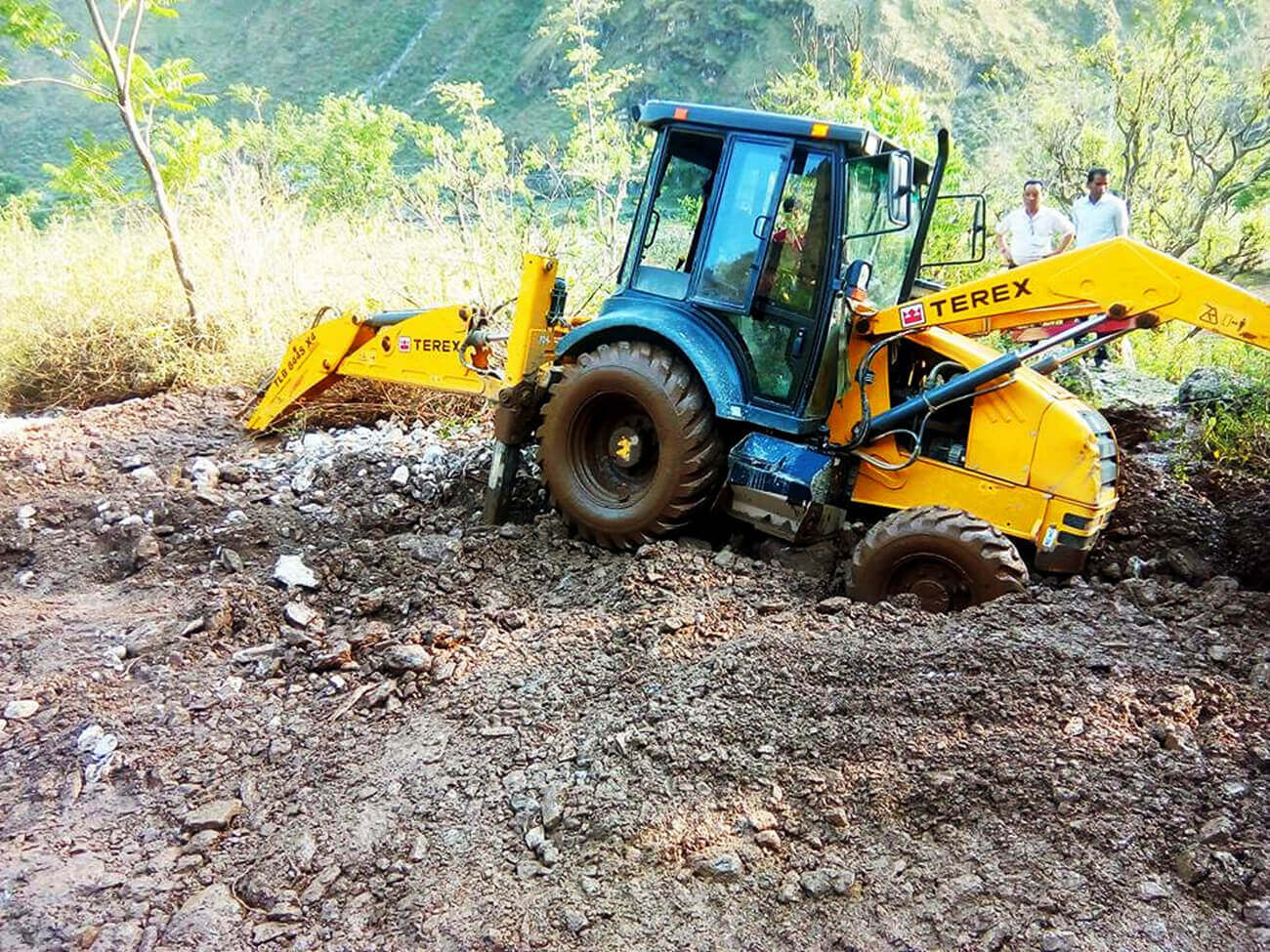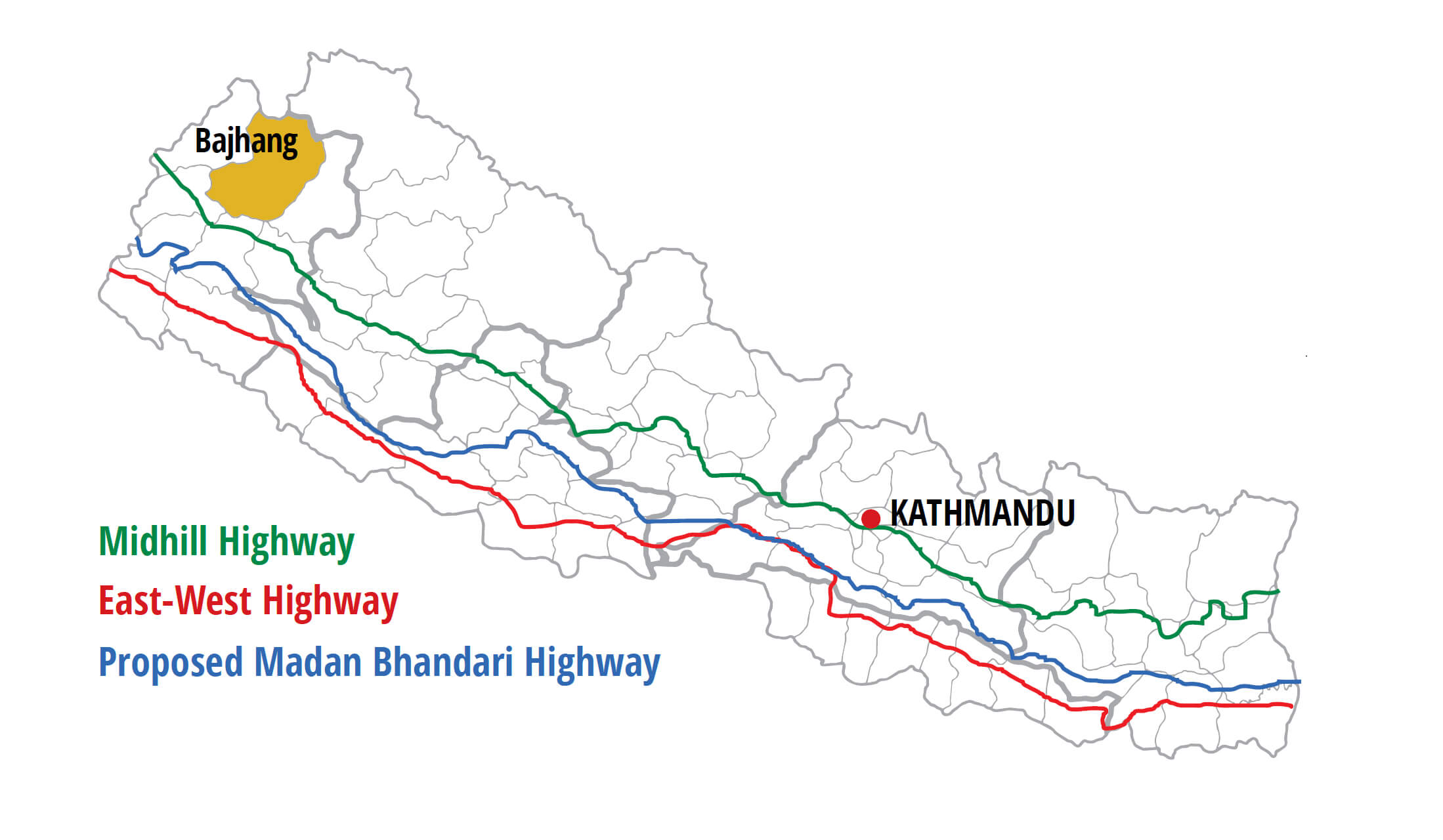From nowhere to nowhere

Paramananda Joshi is 90, but in his long life he had never seen anything like it. The flash-flood swept though his village of Malumela here in the remote mountains of far-western Nepal, washing away farms and making 45 families landless in an instant.
In the village of Tollodhika, the Gole Khola flooded for the first time in living memory. The sudden flood swept away five people crossing the stream. That evening, a jeep carrying five people was washed away by the Chaitya River with a ferocity locals had never seen before.
“It is just a brook, and it had been raining for less than an hour before the floods came down without warning, how did that happen?” asks Ramdal Mijar, 54.
Scientists blame extreme weather events caused by global warming, the impact of which has been exacerbated by a construction spree of unplanned and poorly built roads along fragile mountain slopes.
In all, 10 people have been killed by raging floods since April in this area of Bajhang that has seen much road-digging. The crop damage has been extensive, and pushed many farmers in this already food-deficit region to the brink of starvation.
The Himalayan mid-hills have always had floods and landslides, but how can barely one hour of rain cause such havoc? Why do normally calm streams suddenly turn into angry torrents of mud?
“Cloudbursts are becoming more frequent because of erratic weather caused by climate change. Badly constructed roads upstream that alter natural drainage patterns make the floods worse,” explains the Bajhang soil conservation officer Sunil Kumar Gupta.
Flooding has been prevalent and unpredictable throughout Nepal during unusually heavy pre-monsoon showers this year. But even normal precipitation can trigger landslides because haphazard road construction disturbs natural drainage, unleashing flash-floods downstream.
Finding details about new roads nationwide is impossible. Even the Department of Roads doesn’t have proper records. Bajhang district authorities have no idea where roads are being built, but unofficially we tallied at least 165 currently under construction. There are more than 75 heavy earthmovers in Bajhang alone.
Every infrastructure project must by law have an Environmental Impact Assessment (EIA). None of the new improvised roads here have done EIAs.
Five years ago the Local Development Ministry (LDM) ordered all District Development Committees to notify them of the use of bulldozers and excavators. They were encouraged to minimise the use of diggers, and have have an engineer present when using them.
“These rules are flouted everywhere, no one is enforcing them,” admits Nripraj Joshi of the District Technical Committee. After an earlier expose by the Centre for Investigative Journalism and being questioned by the LDM, several discussions were held. But that did not go anywhere.
Besides floods, road-building has set off rockfalls that have ruined terrace farms. Madan Rokaya has a family of 13, and was once happy that a road was coming to his village. But his terraces were buried by landslides set off by road construction. “I am ruined, I have no land and am now begging for work,” says Rokaya.
Subeda village (pictured below) once had the district’s most fertile farms, and its 30 or so families were well off. But most of its farms have been destroyed by rocks and boulders tumbling down the mountains from a road alignment. The contractor, Lama Golden JV, shows no remorse.

Singh Bir Rokaya says farmers like him are helpless: “We are just spectators, many of our farms are buried under rocks.”
The District Agriculture Office has collected complaints, and says 1,800 families in 40 villages in Bajhang have been affected by road building. Already destitute, many families here have become landless.
It is not just farms that have been destroyed, traditional irrigation systems that hugged the contours of mountains have been blocked or washed away by road construction up the slopes.
Land is being covered and rendered useless, KC says. He questions the logic of such development, when it means people are being displaced. But there is more to the problem, because water supply is also disrupted. Several irrigation structures have fallen prey to the dozers, he says.
“Of the 440 irrigation schemes we had in Bajhang, more than 283 have been destroyed by the bulldozers,” says Rajesh Kumar KC of the Agriculture Development Office here.
“The excuse from local politicians is always the same,” KC says, “they tell us that there is always destruction when there is development. They say destruction is temporary whereas development is permanent.”
Water supply schemes are also affected. The Padamjelya Drinking Water Project in Sireta village that served 72 families and completed last year at a cost of Rs350,000 was damaged two months later by reckless road construction.
“We all volunteered to build this water supply, our dreams are ruined,” says Bijay Joshi. Two other drinking water projects have also been ruined in the area, and locals are back to drinking contaminated water from rivers and springs.

When approached, local politicians often try to shift the blame. One-third of the officials, elected village heads and mayors are contractors, or are from families that own construction companies.
They also own excavators and bulldozers and rent them to the municipalities. Many have been found to be awarding contracts to themselves. Devolution under federalism was supposed to stop such greed and lack of accountability, but it appears to have democratised corruption.
To be sure, there are examples of mountain roads that heed the environment and try to minimise the damage to the local economy. The green road concept tries to ensure minimum disruption to slopes, and plan roads to create farm jobs and market access for produce.
Unfortunately, the roads being built haphazardly by local governments lack many of these essential attributes. Seismologists warn that western Nepal could be hit by a long overdue mega-earthquake, and mountains destabilised by poorly designed roads could trigger catastrophic slope failures.
Says Upama Ojha of Geohazards International: "Things are bad enough during normal times, but the haphazard use of bulldozers have increased landslide risk. It is unthinkable what will happen during an earthquake."
Province 7 Chief Minister Trilochan Bhatta was recently visited by a group of concerned residents of Thalara-9 which was threatened by the risk of flood and landslide. They told him: “It has been three years since we have slept soundly because of the danger from road construction.”
New road constructions even threaten existing highways. Bajhang’--s lifeline to the Tarai was recently black-topped, but rockfall debris from another road up the mountain obstructs it frequently. Last month the important artery was blocked by a landslide triggered by the construction of a feeder-road for two weeks.
“The road should never have been built without analysing the environmental impact, and close supervision of the construction methods,” says Chief Engineer Lalijan Khanal of the Department of Roads in the neighbouring district of Baitadi. He said he wrote repeatedly to the district administration about the danger posed by excavators. “They didn’t listen to me,” he says.
Such obstruction can mean life or death. Five patients died last year because they couldn’t be taken to hospital when the road was blocked for more than a month. The landslide that blocked the highway was caused by excavator activity on the feeder road above it.
Centre for Investigative Journalism
DEADLY TOLL

May 8: Sub-engineer Narayan Dahal died in a landslide at the Chainpur-Taklakot road section in Ramaili.
May 6: Five people, including four of the same family, were killed by a flood in the Guhe River in Thalara village. Livestock was killed. Five houses were swept away and the Juilgad hydropower plant was put out of action.
May 2: Three people were killed when a flashflood swept away their jeep on the Chauthiya river. Over 152 hectares of farms were destroyed, more than 50 livestock were killed.
April 27: Floods caused by road building inundated 130 hectares of land and destroyed crops in Sabik village. Farmers lost Rs300 million worth of standing crops.
Duplication road

It is not just local governments that are on a nationwide road construction spree. The NCP government announced it had set aside Rs 4.5 billion for the so-called Madan Bhandari Highway in its last budget. The new highway will span 1.200 km from Jhapa in the east to Dadeldhura in the west, cross 14 districts – most them in the ecologically fragile Chure Range and the Inner Tarai (depicted on map above).
The announcement caught many by surprise because it was made without conducting an Environmental Impact Assessment or a Detailed Project Report. Moreover, there has been no satisfactory explanation as to why there was a need for another east-west highway when there is already the Mahendra Highway, the Mid-hill Highway and the Tarai Feeder Road project.
When asked, spokesperson Rajendra Sharma of the Ministry of Physical Planning and Transportation said parts of the new highway were already in existence, and the Madan Bhandrai Highway would just connect the missing bits. He also said the region served by the road was rich in limestone deposits, and would serve existing and future cement factories.
“In fact, you could call this a cement highway,” Sharma told us.
However, Dhananjaya Poudel of the Ministry of Environment expressed surprise that his ministry was never consulted about the highway, and that budget was allocated without studying its environmental impact and economic feasibility.
He added: “You have to take into account the geography, geology, vegetation, environment, and the impact on human settlements before undertaking a project like this. Only then can you minimise the damage.”
Kalpana Bhattarai
Read also:
Elected contractors, Mukesh Pokhrel
Trickle down corruption, Editorial
Bulldozing democracy, Om Astha Rai




